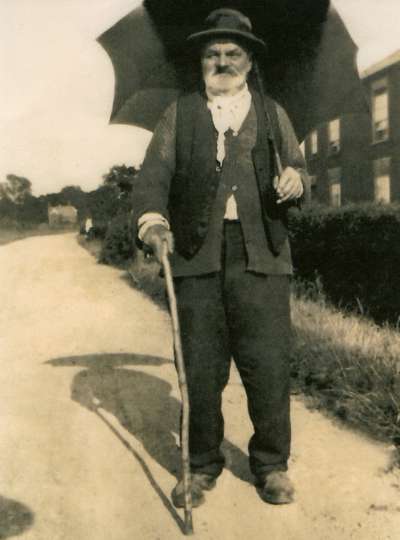A piece of World War 2 shrapnel recently landed back on Mersea - in the Museum letterbox. It came from John Simons, whose family came to live with relatives in East Mersea to escape the bombs coming down around the Chatham Dockyard in Kent. The shrapnel had originally arrived in Mersea in November 1940. Ron Green takes up the story...
On a November night in 1940 a parachute mine fell on East Mersea,
it dropped right in the middle of the road just to the West of the school cutting East Mersea off. The traffic, such as there was, had to go out into the field to get round what was believed to be the second largest crater made by a German bomb during the war.
I well remember hearing the voice of my uncle Frank Richer in the early hours of the morning saying 'Les, we have been bombed out mate'.
He had cycled up to our bungalow in Suffolk Avenue to get help to move to temporary accommodation. My grandparents Jack and Alice Green, their son Arthur, daughter Nellie Richer, her husband Frank and their children Daphne and Keith lived in the West half of Hall Cottages, the other half was the home of Sam and 'Mip' Austin. The damage was caused by large chunks of clay soil which had been thrown into the air crashing through the roof of the cottage. There were lumps of clay the size of a wheelbarrow at the top end of what was later to be known as the Pick your Own field. Another lump went right through the roof of the rectory; there was a car jacked up in there for the duration, and it went down right into the car.
My grandfather received a cut to the neck otherwise there were no other injuries. My grandmother had been an invalid for many years.
I was fourteen years old when she died and I never remember her walking.
They all found accommodation at Weir Farm. It is believed the parachute failed to open as a second mine fell on farmland in Fingringhoe doing little damage but flattening some hedges.

The map is part of a larger map which shows the location of over 140 bombs, incendiaries and crashed planes on Mersea Island during World War 2. The other large bomb on Mersea during the war was the 'Doodlebug' V1 flying bomb which came down to the west of Empress Avenue 7 December 1944 and caused 'considerable damage and two slight casualties.' The explosion damaged a timber framed bungalow in what was then Queensville Road (now Oakwood Avenue) beyond repair. The remains were cleared and a new brick bungalow built.

The piece of aluminium shrapnel is about 8cm across. Black paint on it has survived the years.

Sam Austin senior on East Road with the school in the distance. There is another pair of cottages behind Sam Austin where his son Samuel Ambrose Austin lived, and the bomb fell at the far end of those cottages. Photograph in the 1920s - from Ray Whiting.
By the time of the parachute mine, John Simons had moved to West Mersea and the family escaped the shower of clay, On the subject of the later doodlebug he says "My Uncle rushed from Colchester to our house to check we were alive. He had been listening to Lord Haw Haw who stated that West Mersea Military harbour had been totally destroyed. A bit of an over statement, but the interesting point is that it was said to be the only time he named an actual target!".
Ron Green continues...
I and my family lived on Mersea throughout the war and I often wonder what those people who worry about what will happen if certain developments go ahead would do if faced with the prospect of an enemy invasion and bombs raining down on them. Our parents were no doubt worried but us children didn't really appreciate the dangers. During the school holidays we would be out in the fields all day just popping in for meals then out again. I do remember one occasion when we had come home from school for dinner and were due to go back, our friend Jen who lived opposite used to walk back to school with us. As she waited by the back door she remarked that there was a plane going over with things dropping out of it. Mum quickly hurried us indoors and under the kitchen table. As it happened the bombs fell harmlessly on the marshes. For us schoolboys it was one big adventure. Many of the large houses were left empty, their owners fleeing to safer areas. These houses were at times occupied by the army and we spent a lot of time with the soldiers who would paint our trolleys for us. In the days leading up to 'D' day Empress Avenue was lined with army lorries hiding under the chestnut trees and covered with camouflage nets.
Published in Mersea Life November 2016, page local 85.
|